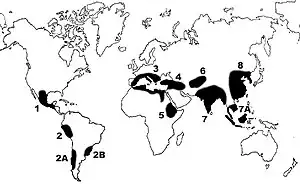
A center of origin is a geographical area where a group of organisms, either domesticated or wild, first developed its distinctive properties.[1] They are also considered centers of diversity. Centers of origin were first identified in 1924 by Nikolai Vavilov.
Plants
Locating the origin of crop plants is basic to plant breeding. This allows one to locate wild relatives, related species, and new genes (especially dominant genes, which may provide resistance to diseases). Knowledge of the origins of crop plants is important in order to avoid genetic erosion, the loss of germplasm due to the loss of ecotypes and landraces, loss of habitat (such as rainforests), and increased urbanization. Germplasm preservation is accomplished through gene banks (largely seed collections but now frozen stem sections) and preservation of natural habitats (especially in centers of origin).
Vavilov centers

A Vavilov Center (of Diversity) is a region of the world first indicated by Nikolai Vavilov to be an original center for the domestication of plants.[3] For crop plants, Nikolai Vavilov identified differing numbers of centers: three in 1924, five in 1926, six in 1929, seven in 1931, eight in 1935 and reduced to seven again in 1940.[4][5]
Vavilov argued that plants were not domesticated somewhere in the world at random, but that there were regions where domestication started. The center of origin is also considered the center of diversity.
Vavilov's scheme as updated by Schery and Janick
Vavilov centers are regions where a high diversity of crop wild relatives can be found, representing the natural relatives of domesticated crop plants.
Cultivated plants of eight world centers of origin [6][7]
| Center | Plants |
|---|---|
| 1) South Mexican and Central American Center | Includes southern sections of Mexico, Guatemala, El Salvador, Honduras and Costa Rica.
|
| 2) South American Center | 62 plants listed; three subcenters
2) Peruvian, Ecuadorean, Bolivian Center:
2A) Chiloé Center (Archipelago near the coast of southern Chile)
2B) Brazilian-Paraguayan Center |
| 3) Mediterranean Center | Includes all of Southern Europe and Northern Africa bordering the Mediterranean Sea. 84 listed plants
|
| 4) Middle East | Includes interior of Asia Minor, all of Transcaucasia, Iran, and the highlands of Turkmenistan. 83 species
|
| 5) Abyssinian Center | Includes Ethiopia, Eritrea, and part of Somalia. 38 species listed; rich in wheat and barley.
|
| 6) Central Asiatic Center | Includes Northwest India (Punjab, Northwest Frontier Provinces and Kashmir), Afghanistan, Tajikistan, Uzbekistan, and western Tian-Shan. 43 plants |
| 7) Indian Center | Two subcenters
7) Indo-Burma: Main Center (India): Includes Assam, Bangladesh and Burma, but not Northwest India, Punjab, nor Northwest Frontier Provinces, 117 plants
7A) Siam-Malaya-Java: statt Indo-Malayan Center: Includes Indo-China and the Malay Archipelago, 55 plants
|
| 8) Chinese Center | A total of 136 endemic plants are listed in the largest independent center
|
Purugganan and Fuller 2009 scheme
| Center | Plants | Years before present |
|---|---|---|
|
4,500–4,000 years | ||
|
2) Mesoamerica |
10,000 | |
|
9,000–7,000 | ||
|
2a) northern lowland neotropics |
Cucurbita moschata, Ipomoea batatas, Phaseolus vulgaris, tree crops |
9,000–8,000 |
|
3) central mid-altitude Andes |
5,000 | |
|
3a) north and central Andes, mid-altitude and high altitude areas |
Solanum tuberosum, Oxalis tuberosa, Chenopodium pallidicaule |
8,000 |
|
3b) lowland southern Amazonia |
8,000 | |
|
Phaseolus lunatus, Canavalia plagiosperma, and Cucurbita ecuadorensis |
10,000 | |
|
4) western sub-Saharan African |
4,500 | |
|
4a) west African savanna and woodlands |
3,700 | |
|
<3,000 | ||
|
4b) west African rainforests |
poorly documented | |
|
>4,000? | ||
|
6) east African uplands |
4,000? | |
|
east African lowlands |
vegeculture of Dioscorea cayennensis and Ensete ventricosum |
poorly documented |
|
7) Near East |
Hordeum vulgare, Triticum spp., Lens culinaris, Pisum sativum, Cicer arietinum, Vicia faba |
13,000–10,000 |
|
7a) eastern Fertile Crescent |
additional Hordeum vulgare |
|
|
9,000 | ||
|
8a) Gujarat, India |
5,000? | |
|
8b) Upper Indus |
5,000 | |
|
8c) Ganges |
8,500–4,500 | |
|
8d) southern India |
5,000–4,000 | |
|
5,000? | ||
|
10) northern China |
8,000 | |
|
4,500? | ||
|
11) southern Hokkaido, Japan |
4,500 | |
|
12) Yangtze River Valley, China |
9,000–6,000 | |
|
12a) southern China |
Colocasia spp., Coix lacryma-jobi |
poorly documented, 4,500? |
|
13) New Guinea and Wallacea |
Colocasia esculenta, Dioscorea esculenta, and Musa acuminata |
7,000 |
See also
References
- ↑ "International Treaty on Plant Genetic Resources for Food and Agriculture" (PDF). Food and Agriculture Organization of the United Nations. 2009. p. Article 2.
- ↑ Diamond, J.; Bellwood, P. (2003). "Farmers and Their Languages: The First Expansions". Science. 300 (5619): 597–603. Bibcode:2003Sci...300..597D. CiteSeerX 10.1.1.1013.4523. doi:10.1126/science.1078208. PMID 12714734. S2CID 13350469.
- ↑ Blaine P. Friedlander Jr (June 20, 2000). "Cornell and Polish research scientists lead effort to save invaluable potato genetic archive in Russia". Retrieved March 19, 2008.
- ↑ Vavilov, N. I.; Löve, Doris (trans.) (1992). Origin and Geography of Cultivated Plants. Cambridge University Press. p. xxi. ISBN 978-0521404273.
- ↑ Corinto, Gian Luigi (2014). "Nikolai Vavilov's Centers of Origin of Cultivated Plants With a View to Conserving Agricultural Biodiversity". Human Evolution. 29 (4): 285–301.
- ↑ Adapted from Vavilov (1951) by R. W. Schery, Plants for Man, Prentice Hall, Englewood Cliffs, NJ, 1972
- ↑ History of Horticulture, Jules Janick, Purdue University, 2002
- ↑ Gross, B. L.; Zhao, Z. (April 21, 2014). "Archaeological and genetic insights into the origins of domesticated rice". Proceedings of the National Academy of Sciences. 111 (17): 6190–6197. Bibcode:2014PNAS..111.6190G. doi:10.1073/pnas.1308942110. PMC 4035933. PMID 24753573.
- ↑ Purugganan, Michael D.; Fuller, Dorian Q. (2009). "The nature of selection during plant domestication". Nature. Nature Research. 457 (7231): 843–848. Bibcode:2009Natur.457..843P. doi:10.1038/nature07895. ISSN 0028-0836. PMID 19212403. S2CID 205216444.